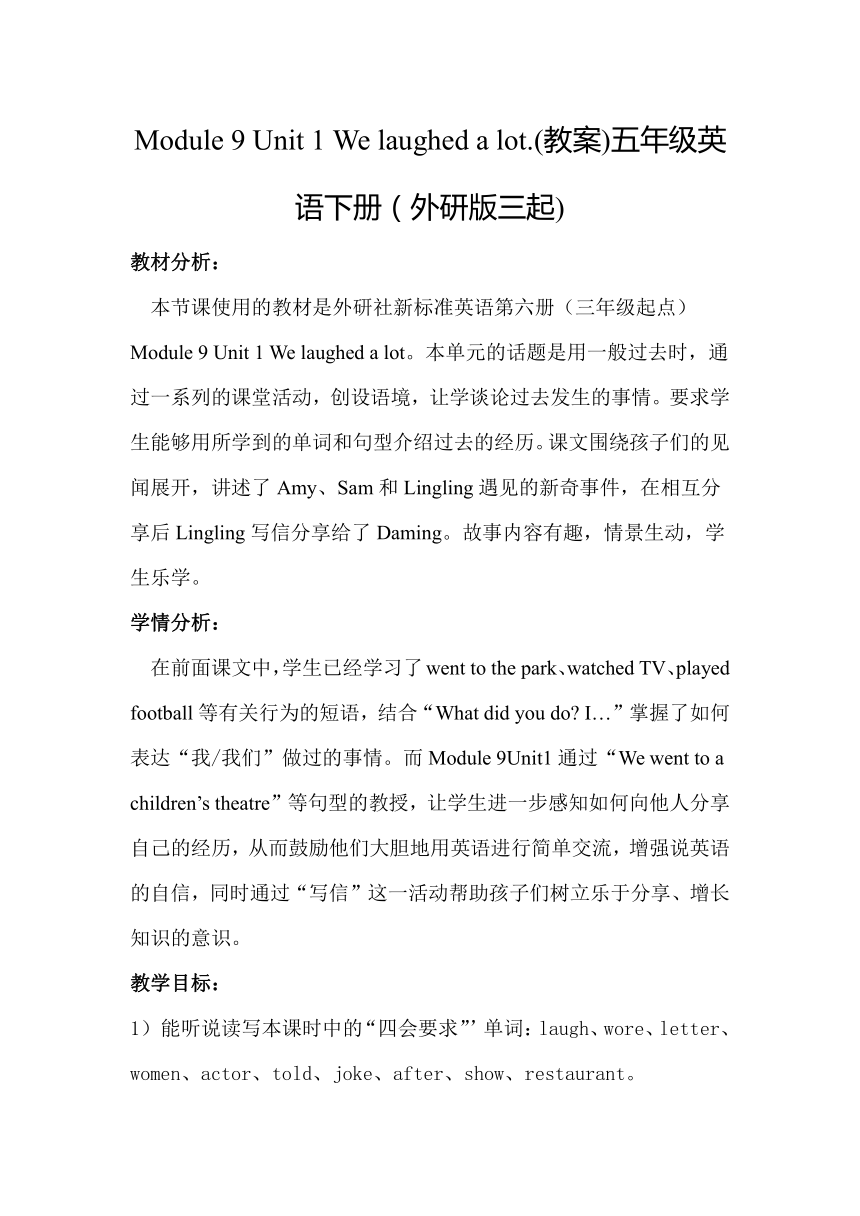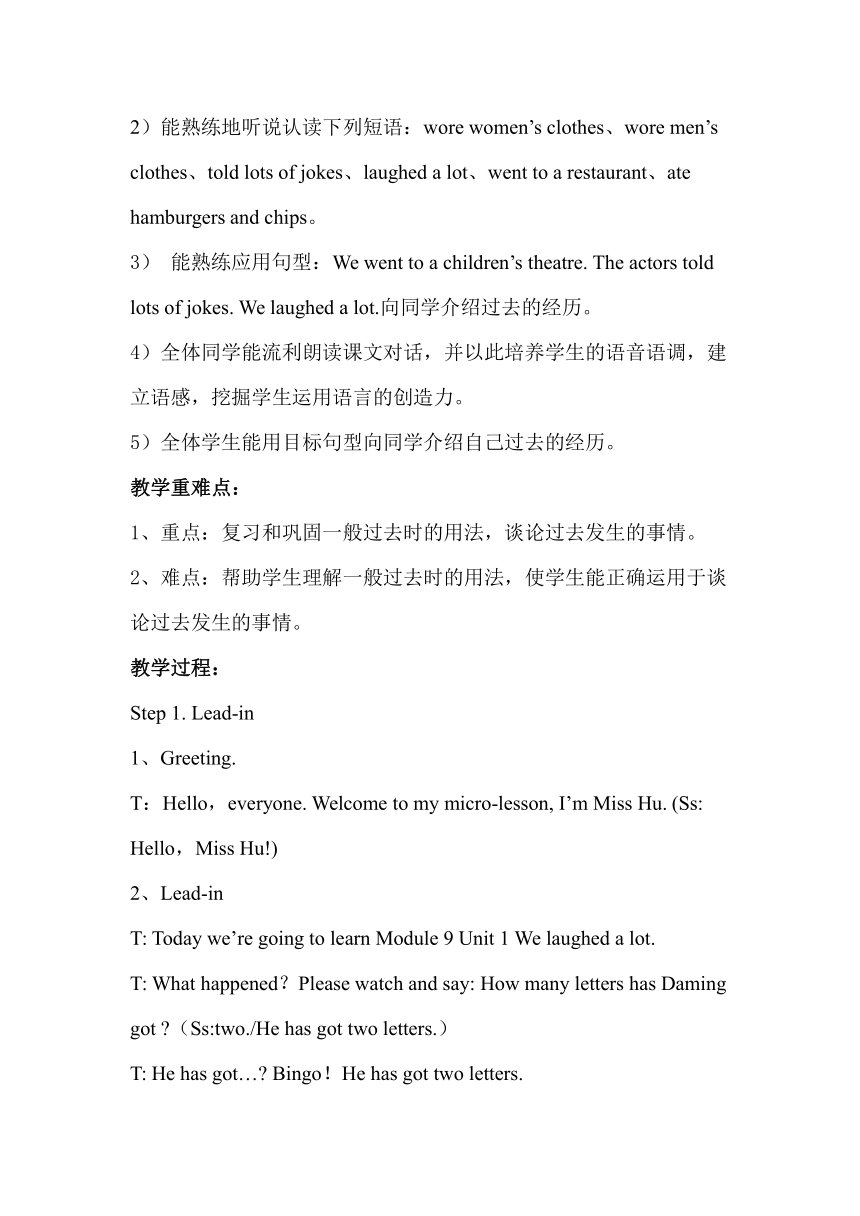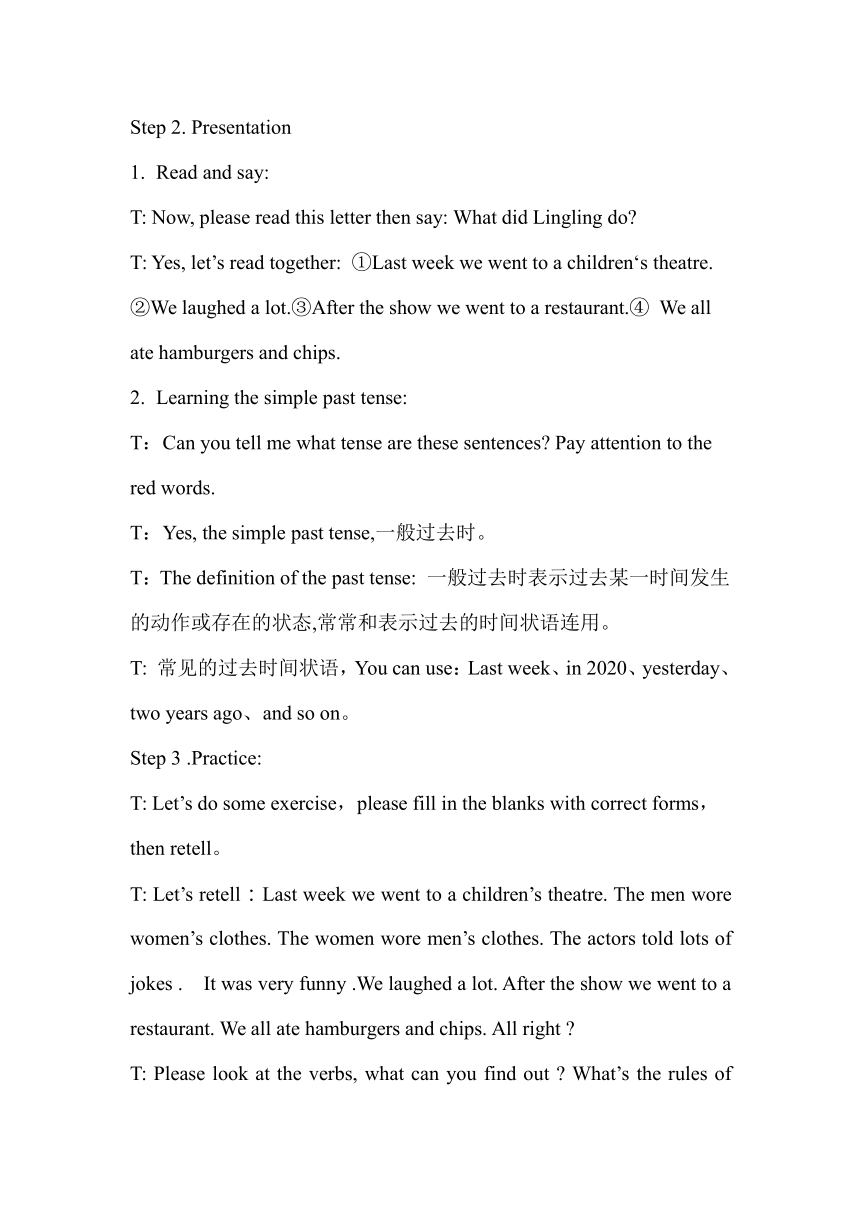Module 9 Unit 1 We laughed a lot 教案
文档属性
| 名称 | Module 9 Unit 1 We laughed a lot 教案 |

|
|
| 格式 | docx | ||
| 文件大小 | 92.0KB | ||
| 资源类型 | 教案 | ||
| 版本资源 | 外研版(三年级起点) | ||
| 科目 | 英语 | ||
| 更新时间 | 2023-10-29 11:39:05 | ||
图片预览



文档简介
Module 9 Unit 1 We laughed a lot.(教案)五年级英语下册(外研版三起)
教材分析:
本节课使用的教材是外研社新标准英语第六册(三年级起点)Module 9 Unit 1 We laughed a lot。本单元的话题是用一般过去时,通过一系列的课堂活动,创设语境,让学谈论过去发生的事情。要求学生能够用所学到的单词和句型介绍过去的经历。课文围绕孩子们的见闻展开,讲述了Amy、Sam和Lingling遇见的新奇事件,在相互分享后Lingling写信分享给了Daming。故事内容有趣,情景生动,学生乐学。
学情分析:
在前面课文中,学生已经学习了went to the park、watched TV、played football等有关行为的短语,结合“What did you do I…”掌握了如何表达“我/我们”做过的事情。而Module 9Unit1通过“We went to a children’s theatre”等句型的教授,让学生进一步感知如何向他人分享自己的经历,从而鼓励他们大胆地用英语进行简单交流,增强说英语的自信,同时通过“写信”这一活动帮助孩子们树立乐于分享、增长知识的意识。
教学目标:
能听说读写本课时中的“四会要求”’单词:laugh、wore、letter、women、actor、told、joke、after、show、restaurant。
能熟练地听说认读下列短语:wore women’s clothes、wore men’s clothes、told lots of jokes、laughed a lot、went to a restaurant、ate hamburgers and chips。
能熟练应用句型:We went to a children’s theatre. The actors told lots of jokes. We laughed a lot.向同学介绍过去的经历。
全体同学能流利朗读课文对话,并以此培养学生的语音语调,建立语感,挖掘学生运用语言的创造力。
全体学生能用目标句型向同学介绍自己过去的经历。
教学重难点:
重点:复习和巩固一般过去时的用法,谈论过去发生的事情。
难点:帮助学生理解一般过去时的用法,使学生能正确运用于谈论过去发生的事情。
教学过程:
Step 1. Lead-in
1、Greeting.
T:Hello,everyone. Welcome to my micro-lesson, I’m Miss Hu. (Ss: Hello,Miss Hu!)
2、Lead-in
T: Today we’re going to learn Module 9 Unit 1 We laughed a lot.
T: What happened?Please watch and say: How many letters has Daming got (Ss:two./He has got two letters.)
T: He has got… Bingo!He has got two letters.
Step 2. Presentation
Read and say:
T: Now, please read this letter then say: What did Lingling do
T: Yes, let’s read together: ①Last week we went to a children‘s theatre. ②We laughed a lot.③After the show we went to a restaurant.④ We all ate hamburgers and chips.
Learning the simple past tense:
T:Can you tell me what tense are these sentences Pay attention to the red words.
T:Yes, the simple past tense,一般过去时。
T:The definition of the past tense: 一般过去时表示过去某一时间发生的动作或存在的状态,常常和表示过去的时间状语连用。
T: 常见的过去时间状语,You can use:Last week、in 2020、yesterday、two years ago、and so on。
Step 3 .Practice:
T: Let’s do some exercise,please fill in the blanks with correct forms,then retell。
T: Let’s retell:Last week we went to a children’s theatre. The men wore women’s clothes. The women wore men’s clothes. The actors told lots of jokes . It was very funny .We laughed a lot. After the show we went to a restaurant. We all ate hamburgers and chips. All right
T: Please look at the verbs, what can you find out What’s the rules of regular verbs
T: Let’s see:
No.1 结尾是e的动词+d ,例如live-lived。
No.2 一般在动词末尾+ed ,例如laugh-laughed。
No.3 结尾是“辅音字母+y”的,变“y”为“i”再+ed,例如study-studied。
No.4 末尾只有一个辅音字母的重读闭音节,先双写辅音字母,再+ed,例如stop-stopped。
T: Except regular verbs, there are some irregular verbs, like: am/is-was, wear-wore,are-were, eat-ate,go- went, take-took. And so on.
T: After learning these words, Can you read this sentence?Together: It was very funny. 同学们,一般过去时的句子结构是怎样的呢?开动脑经想一想。肯定句结构,老师总结为主语+be(was/were)+其他。
T: How about this one ?We laughed a lot. 一般过去时的第二种肯定句结构:主语+实义动词过去式+其它。
Step 4 . Summary:
T: Now, let’s summarize what we have learned today. We have learned the definition of the simple past tense、the symbol words、 the rules of regular verbs and some irregular verbs and the structure.
T: So much for today, goodbye!
Homework:
1、Read the text after the e-pen。
2、Write a letter and send it to your friend, talk about what did you do last week.
Blackboard Design:
教材分析:
本节课使用的教材是外研社新标准英语第六册(三年级起点)Module 9 Unit 1 We laughed a lot。本单元的话题是用一般过去时,通过一系列的课堂活动,创设语境,让学谈论过去发生的事情。要求学生能够用所学到的单词和句型介绍过去的经历。课文围绕孩子们的见闻展开,讲述了Amy、Sam和Lingling遇见的新奇事件,在相互分享后Lingling写信分享给了Daming。故事内容有趣,情景生动,学生乐学。
学情分析:
在前面课文中,学生已经学习了went to the park、watched TV、played football等有关行为的短语,结合“What did you do I…”掌握了如何表达“我/我们”做过的事情。而Module 9Unit1通过“We went to a children’s theatre”等句型的教授,让学生进一步感知如何向他人分享自己的经历,从而鼓励他们大胆地用英语进行简单交流,增强说英语的自信,同时通过“写信”这一活动帮助孩子们树立乐于分享、增长知识的意识。
教学目标:
能听说读写本课时中的“四会要求”’单词:laugh、wore、letter、women、actor、told、joke、after、show、restaurant。
能熟练地听说认读下列短语:wore women’s clothes、wore men’s clothes、told lots of jokes、laughed a lot、went to a restaurant、ate hamburgers and chips。
能熟练应用句型:We went to a children’s theatre. The actors told lots of jokes. We laughed a lot.向同学介绍过去的经历。
全体同学能流利朗读课文对话,并以此培养学生的语音语调,建立语感,挖掘学生运用语言的创造力。
全体学生能用目标句型向同学介绍自己过去的经历。
教学重难点:
重点:复习和巩固一般过去时的用法,谈论过去发生的事情。
难点:帮助学生理解一般过去时的用法,使学生能正确运用于谈论过去发生的事情。
教学过程:
Step 1. Lead-in
1、Greeting.
T:Hello,everyone. Welcome to my micro-lesson, I’m Miss Hu. (Ss: Hello,Miss Hu!)
2、Lead-in
T: Today we’re going to learn Module 9 Unit 1 We laughed a lot.
T: What happened?Please watch and say: How many letters has Daming got (Ss:two./He has got two letters.)
T: He has got… Bingo!He has got two letters.
Step 2. Presentation
Read and say:
T: Now, please read this letter then say: What did Lingling do
T: Yes, let’s read together: ①Last week we went to a children‘s theatre. ②We laughed a lot.③After the show we went to a restaurant.④ We all ate hamburgers and chips.
Learning the simple past tense:
T:Can you tell me what tense are these sentences Pay attention to the red words.
T:Yes, the simple past tense,一般过去时。
T:The definition of the past tense: 一般过去时表示过去某一时间发生的动作或存在的状态,常常和表示过去的时间状语连用。
T: 常见的过去时间状语,You can use:Last week、in 2020、yesterday、two years ago、and so on。
Step 3 .Practice:
T: Let’s do some exercise,please fill in the blanks with correct forms,then retell。
T: Let’s retell:Last week we went to a children’s theatre. The men wore women’s clothes. The women wore men’s clothes. The actors told lots of jokes . It was very funny .We laughed a lot. After the show we went to a restaurant. We all ate hamburgers and chips. All right
T: Please look at the verbs, what can you find out What’s the rules of regular verbs
T: Let’s see:
No.1 结尾是e的动词+d ,例如live-lived。
No.2 一般在动词末尾+ed ,例如laugh-laughed。
No.3 结尾是“辅音字母+y”的,变“y”为“i”再+ed,例如study-studied。
No.4 末尾只有一个辅音字母的重读闭音节,先双写辅音字母,再+ed,例如stop-stopped。
T: Except regular verbs, there are some irregular verbs, like: am/is-was, wear-wore,are-were, eat-ate,go- went, take-took. And so on.
T: After learning these words, Can you read this sentence?Together: It was very funny. 同学们,一般过去时的句子结构是怎样的呢?开动脑经想一想。肯定句结构,老师总结为主语+be(was/were)+其他。
T: How about this one ?We laughed a lot. 一般过去时的第二种肯定句结构:主语+实义动词过去式+其它。
Step 4 . Summary:
T: Now, let’s summarize what we have learned today. We have learned the definition of the simple past tense、the symbol words、 the rules of regular verbs and some irregular verbs and the structure.
T: So much for today, goodbye!
Homework:
1、Read the text after the e-pen。
2、Write a letter and send it to your friend, talk about what did you do last week.
Blackboard Design:
同课章节目录
- Module 1
- Unit 1 We lived in a small house.
- Unit 2 She didn't have a television.
- Module 2
- Unit 1 She learnt English.
- Unit 2 Mr Li was a teacher.
- Module 3
- Unit 1 She had eggs and sausages.
- Unit 2 Sam ate four hamburgers.
- Module 4
- Unit 1 Let's make a home library.
- Unit 2 We can find information from books and CDs.
- Module 5
- Unit 1 It's big and light.
- Unit 2 It's too big for you.
- Module 6
- Unit 1 I went there last year.
- Unit 2 She visited the Tianchi Lake.
- Module 7
- Unit 1 My father goes to work at eight o'clock eve
- Unit 2 I'll be home at seven o'clock.
- Module 8
- Unit 1 Will you help me?
- Unit 2 I made a kite.
- Module 9
- Unit 1 We laughed a lot.
- Unit 2 Mum bought new T-shirts for you.
- Module 10
- Unit 1 Where are you going to go?
- Unit 2 I'm in New York now.
- Review Module
- Unit 1
- Unit 2
